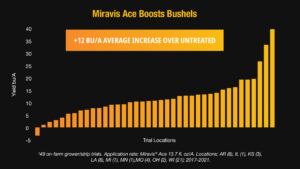This Syngenta fungicide brings consistent protection and plant health to wheat even across inconsistent years.
Volatility looms over almost every day for a grower. Maybe Mother Nature delivers a devastatingly prolonged dry spell or a surprise volley of late-season snow. Maybe the market’s unrest has you checking your phone several times for the latest on commodity prices. Maybe you’ll be kept out of the field because you’re unable to quickly diagnose an issue with a piece of machinery.
For all of the stresses and uncertainties that a farmer faces, it’s comforting to find something that delivers consistency.
Miravis® Ace, Syngenta’s wheat fungicide that incorporates ADEPIDYN® technology, has been around since 2018 and has proven itself to be a key performer toward higher-yielding and better-quality wheat.
“Miravis Ace on my wheat has been the best fungicide I’ve found,” said Bradley Richardson, a grower from Culleoka, Tennessee. “Not only does it increase yield and test weight, but it also keeps the straw cleaner and brighter.”
It’s one of the few commercially available solutions for Fusarium head blight, also known as head scab, that is not fully dependent on triazole chemistry. It has also proven effectiveness against rusts, Septoria, and several other wheat pathogens. Partnered with a unique suite of plant-health benefits, growers consistently see impressive bu/A improvements with Miravis Ace compared to less effective fungicides.
Across 60 trials, Miravis Ace produced an 11.6 bu/A increase over untreated acres1, and over 50 trials, it ushered in anywhere from a 4.8 to 6.0 bu/A average over its competitors, including Caramba®2, Prosaro® PRO 400 SC3, and Prosaro® 421 SC4.

Due to a unique molecular structure and related properties, the ADEPIDYN technology in Miravis Ace is a broad-spectrum carboxamide SDHI fungicide and is celebrated as a next-generation approach to wheat crop protection.
It helps to lower the leaf transpiration rate in plants to make them more tolerant to drought, but it does so without negatively affecting the photosynthetic properties of the plant. It also creates a reservoir within the wax layer of the leaf that withstands rain and degradation.
“With Miravis Ace, we are seeing a yield bump, the heads are cleaner, and I like to believe the longer our fields stay green, the better the potential yield,” said Steven Pfeifer, a grower from Bowbells, North Dakota. “Between 2019 and 2020, we had two totally different scenarios, two different sets of pressures, and we still saw similar results. It’s interesting to see how Miravis Ace has been consistent in inconsistent years.”
North Dakota endured a particularly severe drought in 2020 and 2021 before it began to ease in the years to follow. Stress reactions during a drought force wheat to become less efficient with both water and nutrients, which can lead to cell destruction in the plant. And once those cells are lost, there’s no gaining them back. This puts a premium on nurturing the plant through such a tough environment, whether its something like disease pressure, crop stress or drought.
Because there are many environmental factors that can negatively impact a wheat crop, it’s not always clear which one is going to take precedence. Making Miravis Ace a part of the plan — and sticking to that plan — is going to give wheat its best chance to thrive and reach optimal yield.
“As we keep a plant greener, longer and make it more efficient, we will add yield consistently, whether it be in a dry season or if we get into that wet season where, all of a sudden, diseases are more prevalent,” said Dean Grossnickle, Technical Development Lead for the West Heartland Commercial Unit at Syngenta. “That’s why it’s a good rule of thumb or good practice to make Miravis Ace a standard in your program.”
According to Grossnickle, growers who apply Miravis Ace to their wheat crop typically return year after year to use it again.

It becomes important to stay on top of these protective measures because Fusarium is much more prevalent today than it was 20 years ago, impacting as much as 40 percent to 50 percent of a wheat crop in a bad year. Growers seeking consistent protection are seeing the potential that a better modern fungicide like Miravis Ace can bring to their operations and the improved ROI to be had.
“I have been putting Miravis Ace on 100 percent of all wheat acres the last few years, and I have had great results. I wouldn’t go without using them,” said grower Eldon Sell of Ohio. “The plant-health benefits are so important, even in a dry year.”
The preventive qualities of the ADEPIDYN technology also allow Miravis Ace to have a more flexible application window than its competitors. It allows head blight applications as early as 50 percent head emergence up to flowering, positioning growers to protect the wheat heads and tillers — even ones that haven’t emerged yet — and lower their deoxynivalenol (DON) levels in wheat. Most traditional triazole fungicides must be applied at flowering because they’re largely curative and have to attack the pathogen while it’s actively trying to infect the plant.
“When you’ve got several thousand acres and you’re trying to apply in a window of three or four days, which is what the flowering window is, having that bit of extra flexibility is a big benefit,” explained Tyler Harp, Syngenta Technical Product Lead for Row Crop Fungicides.
And in times like this, you want to leave as little as possible to chance.
This article was published on behalf of Syngenta. Visit this page to find a Syngenta Crop Protection Specialist near you.
Ryan Tipps is the founder and managing editor of AGDAILY. He has covered farming since 2011, and his writing has been honored by state- and national-level agricultural organizations.



